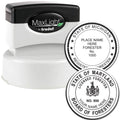If you’re looking to add a dash of elegance to your labels, an embossing stamp for labels can make them pop without a ton of extra work. Instead of handing out plain stickers or handwriting each one, you can create a raised design that feels unique and personal. Plus, a crisp embossed finish instantly says, “I put some thought into this.”
Below, you’ll learn the basics of embossing, how to pick a design that suits your style, and ways to keep your embossing tool in tip-top shape. Let’s dive in.
Discover embossing magic
What is embossing?
Embossing is a process where you press a raised image or text onto a surface, often using a handheld embosser. The result is a design that’s literally raised, so you can see and feel it. Think of your next book plate or gift tag: suddenly, it transforms into a mini statement piece.
Why it elevates your labels
When you emboss a label, the design catches the eye right away. It’s like turning ordinary paper into something collectible. That extra texture also provides a subtle nod to your style. Whether you’re labeling homemade jams or personalizing your book collection, embossing shows genuine care.
Choose your perfect design
Classic, modern, or whimsical
Each design sends its own vibe. A sleek monogram feels timeless, while bold fonts with funky borders look playful. Engineer Seal Stamps (ESS) offers a variety of ready-to-use motifs. If you love minimalist touches, go for slim lines and clean type. If you prefer flair, choose swirling ornaments or floral frames.
Go for personalization
You can put your name, family initials, or a short phrase on your custom plate. This is especially handy for book lovers who want a personalized library seal. Looking for something truly one-of-a-kind? Check out custom embossing stamps to craft an embosser that fits you to a T.
Use your embosser effectively
Setting up your stamp
- Slide your label or paper between the embosser plates.
- Make sure you align your design exactly where you want it.
- Press the handle down firmly, then release.
Pro tip: Practice on scrap paper first so you get a feel for how much pressure to use.
Ensuring a crisp impression
A solid grip and steady hand lead to a clean result. If the sheet feels too thin, layer it with a second piece of paper for extra thickness. That way, the plates can make deeper contact. Also, keep your work surface flat and avoid stamping while standing up with shaky arms—trust me, a stable table is your best friend.
Maintain and store your embosser
Simple cleaning tips
After a few uses, tiny paper fibers can linger on your plates. Gently brush or wipe away any debris. Steer clear of harsh chemicals that might damage the metal. A soft cloth with mild soap should do the trick.
Keep the plates protected
Humid areas might increase the chance of rust. If you live in a damp climate, store your embosser in a dry, sealed container. For extra long life, slip a small packet of silica gel in there to absorb moisture. Quick and easy.
Explore practical uses
An embosser isn’t just for name labels, though that’s a great start. You can also:
- Make personalized seals for holiday cards or fancy envelopes.
- Mark your journals or notebooks.
- Add flair to gift tags or place cards at events.
- Brand product packaging with your logo or initials.
Engineer Seal Stamps (ESS) designs handle all these tasks easily, so you can show off a polished touch whenever you want.
Wrap up your stamping adventure
Embossing gives your labels a memorable look and feel. By choosing a design that reflects your personality and taking good care of your embosser, you’ll enjoy crisp impressions for ages. Whether you’re labeling homemade crafts or commemorating a book collection, these raised designs add a professional finish with minimal fuss. Ready to get started? Give embossing atry, and see how a simple press can transform your everyday labels.
Frequently asked questions
Does embossing work on all paper types?
Generally, yes, but it’s best on thicker, sturdier paper. Extremely thin papers might tear or produce a weaker impression.Is it hard to change the design?
With a handheld embosser, changing the design usually involves swapping out the metal plate. Many suppliers provide replacement plates for various designs.Can I emboss glossy or coated surfaces?
You can, but use gentle pressure to avoid smearing or slipping. Test a sample piece first to be sure it embosses cleanly.How long do custom embosser plates last?
High-quality metal plates from companies like Engineer Seal Stamps can last years if stored properly and cleaned gently.What if my embossing looks uneven?
Try applying more consistent pressure, or place a thicker backing sheet underneath. If the problem persists, inspect the plates for debris or damage. A quick wipe might solve the issue.


















